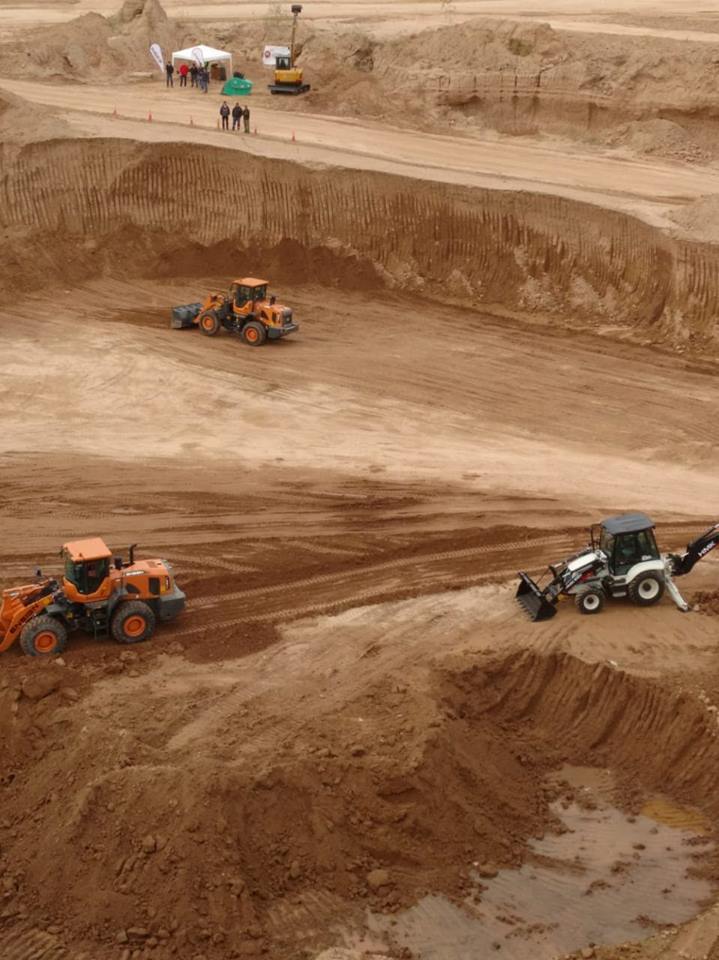Service Tel:
+86-536-6298882
Email:
export@ensignhi.com
ADD:
No.1567, ENSIGN Street , Economic Development
Zone, Changle,Weifang, Shandong, China
© Ensign Heavy Industries Co., Ltd. all rights reserved
鲁ICP备12026776号-3 鲁ICP备12026776号
5 Tips to Extend Loader Life
Even the most skilled operator can diminish wheel loader longevity and productivity by misusing certain functions or by operating the machine in a manner that causes premature component wear. The risks increase exponentially when a new operator gets behind the controls.

That’s why manufacturers stress the importance of operator training regardless of experience level. Many manufacturers, along with their dealers, offer training programs with the purchase of a new machine. “For a lot of companies, if they would accept the manufacturer’s operator training, that would take care of a lot of [the problems],” says Doug Phillips, product competence manager, Volvo Construction Equipment.
Often, an operator doesn’t realize he may be using the machine incorrectly. “He thinks he’s fine. But if he doesn’t get some education about all the new technologies, then he operates the wheel loader like it’s still a machine built in the ’70s,” Phillips notes. “The technology is changing so fast. Operators are often uninformed, and that’s what causes a lot of these issues.”
“Operator training is key — making sure that the operator knows the machine and all its functions,” adds Chad Ellis, product manager, heavy, Doosan Infracore Construction Equipment. Loader functions can differ between brands. “Make sure the operator is trained on that particular machine so he knows exactly what he’s doing and what button he is pushing.”
The operator’s manual is an invaluable resource. “Besides basic training on wheel loaders, the operator should read the manual that outlines proper techniques,” stresses John Chesterman, product marketing manager, four-wheel-drive loaders, John Deere. It will also describe features that can improve operator productivity and comfort. “So the time invested in studying the manual can have significant payback to the owner in getting more work done.”
Following is a look at some common problem areas associated with wheel loader operation, along with some suggestions on how to address them.
Take it easy on buckets
According to Ellis, the most common wear areas on loaders are the front pins, bucket, bucket wear plates and teeth, if applicable. Such wear is accelerated by lack of general maintenance. For example, lack of greasing will accelerate the wear of the front pin. As such, it’s important to follow greasing and other daily service guidelines prescribed in the operator’s manual.
Inattention to buckets can prove costly. “Make sure you turn or replace wear plates on the front of the bucket before you start tearing up the bucket itself,” Ellis cautions. “If you let those wear down to where you start wearing on the bucket, you can cost yourself a lot of money before you need to.”
The choice of bucket can also affect overall wear and tear on the front end of the machine. “If the operators don’t have buckets that enter the material easily, they put a lot of undue stress on the pins and bushings where the attachments affix to the wheel loaders,” says Phillips. “They may run the rpms wide open and hit the pile with excessive force, which can stress a badly designed bucket. That causes bushing and pin wear on the front of the machine, extra fuel costs, etc.”
Selecting buckets specifically suited to the application and material will enable more efficient loader operation, while minimizing front-end component wear.
Cool it on the brakes
All loader brakes (except on hydrostatic machines) work by friction, which generates heat, product experts at Kawasaki point out. If the brakes are over-applied, overheating and premature wear will occur, which can result in early brake failure. Common causes include:
•untrained operators going too fast and then making short, quick stops
•unintentional application by “riding” the brake pedals
•hurried operators (under pressure to be more productive) going heavy on the throttle and then heavy on the brakes to stop fast or in a shorter distance
To extend brake life, Kawasaki recommends training operators to slow down earlier and allow the weight of the machine and load to bring the loader to a near stop before applying the brakes.
It’s also important to understand how to effectively use the declutch mechanism. “We see a lot of operators who are not utilizing declutch,” Phillips comments. “They’re driving through the brakes as they’re going to the hopper or truck, which causes excessive brake wear.”
Declutch neutralizes the transmission during the braking cycle. “When you push down on it, you put the transmission in neutral and then you hit the brake,” Phillips explains. “Once you engage the brake, then if you’re pressing on the accelerator to use the hydraulic part of the machine — move the boom or bucket up and down — the machine is not pulling against the brake.
“If operators will utilize declutch properly,” he adds, “they will disengage the transmission and won’t have this pulling effect as they’re working the hydraulics.”
Don’t take shifting shortcuts
Transmission and transmission clutch wear can be a concern, depending on how the machine is being operated. “Improper shifting can cause additional wear and tear,” says Ellis.
High-speed shifts are the most common culprit. “In other words, the operator is using the transmission and torque converter to change direction of the machine,” Phillips states. The operator reverses the loader, “shoves” it into forward gear and hits the accelerator, or vice versa. “They are loading trucks all day and never touch the brakes, taking all that excessive force into the transmission and torque converter and overheating those components.”
While performed in order to achieve faster cycle times, this shifting technique can result in premature failure of very expensive components. As such, manufacturers are taking the choice of whether or not to brake out of the operator’s hands.
Volvo’s Optishift transmission, standard on its 5-yd. and larger loaders, allows the operator to continue to perform high-speed shifts, but ensures the brake is applied. “We call it reverse by braking,” says Phillips. “Any time you’re trying to reverse the machine, if the computer senses the operator making that high-speed shift, it will turn on the brakes and stop the machine. So even if the operator has that bad habit, he can keep operating just like he has been and the machine will take care of that problem and protect itself.”
Additional automated functions are being incorporated into loaders to protect critical system components. For example, John Deere loaders are designed to protect against overheating. “If a system overheats (such as the engine or transmission), the engine will go into a derated mode to prevent further damage,” Chesterman points out. “If the axles overheat on our Interim Tier 4 models, the operator is warned of the condition.”
Today’s “intelligent” loaders also warn operators as problems occur. Sensors are set up to relay data (temperature, fluid level, pressure) from critical operating systems back to the operator via the instrument panel/display, notes Kawasaki. The lights and gauges are designed to get the operator’s attention so that problems can be identified and addressed before damage occurs.
Take time for warm ups and shutdowns
Loader operators may be tempted to skip the recommended warm-up period at startup. But this can be hard on the engine and hydraulic system.
“Cold oil doesn’t lubricate or travel as well as warm oil, so getting up to operating temperature before operation will increase [component] life,” says Ellis. “Making sure all the fluid levels are correct during daily maintenance is also key.”
“When starting the loader up, it should be allowed to warm per the manufacturer’s guidelines,” adds Chesterman. “Additional systems such as hydraulics and axles don’t warm up until the machine is being worked, so the operator should expect that the machine may not have full performance until these systems come up to temp.”
It’s equally important to allow time for proper shutdown at the end of the day. “All of these big diesel engines are now fed by turbochargers,” says Phillips. “The speed of a turbocharger can average 40,000 to 50,000 rpm. If you don’t let the machine idle and cool down for a minimum of two to three minutes before you shut it off, the turbo is still spinning at 40,000 rpm.”
At that point, oil is no longer going to the turbocharger. “So there’s a lot of wear and tear going on inside that turbo,” Phillips states. “If you cool it down before you turn the machine off, the turbo doesn’t spin as long once shut down. But if it spins for any extensive amount of time, the bearings run dry and the turbo overheats, reducing the life of that very expensive component.”
Manufacturers are working to minimize such risks. “We’re putting timer shutdowns on our machine,” says Phillips. “In other words, the operator cuts the switch off and the machine still idles for three minutes and shuts itself off.” The cost of this option is a bargain compared to the high cost of replacing a turbocharger.
Avoid accelerating tire wear
A number of factors can cause premature wear and failure of loader tires.
“Inexperienced operators are prone to spin the tires, which is one of the worst things for the machine. Once they break traction, they’re doing no more work,” says Phillips. “They don’t utilize the differential locks the way they should to lock the front axle up so that power is distributed to both front tires instead of just going to one, which would reduce the spinning.”
Improper inflation pressure is another common cause of excess wear. “We see a lot of damage by not having the correct pressure in the tires,” Phillips states. “With radial tires, low air pressure equals heat buildup during the day because of the rubber flexing with all that weight on top of it. Without the recommended tire pressure to keep a stiff sidewall, the tires overheat badly. That degrades the rubber compound and the tire doesn’t last as long as it should.”
To combat this problem, John Deere offers an optional integrated tire pressure monitoring system to alert the operator of an inflation issue. An automatic differential will also sense wheel spin and automatically apply the differential locks, decreasing tire wear and delivering increased traction for greater productivity.
In some cases, tire spin is the fault of the tire, not the operator. “One reason for spinning the tires is having the wrong type of tire on the wheel loader for the application,” Phillips asserts. “It’s like putting snow tires on a four-wheel-drive truck. They might not be the best thing for fuel economy or to get the job done. On that one day that it snows, you’re glad to have them, but 90% of the time, they’re not the best for driving.”
It’s important to match tires to the application to ensure optimal service life. “Make sure that the tread pattern meets the application you are in,” Ellis advises. For example, a high tractive tire with a more open tread pattern will wear faster on paved surfaces. “If you’re on concrete or asphalt all the time, you would want an L4 or L5 to cut your wear down as much as possible. If you are on dirt all the time, you would want the more aggressive, tractive tread pattern. So you need to take a close look at the tread pattern based on the kind of tire wear you’re going to get.”
Service TEL:
400-066-1567
ADD:
1567 Yingxuan Street, Changle Economic Development Zone, Weifang, Shandong, China
Copyright © Ensign Heavy all rights reserved
鲁ICP备12026776号















